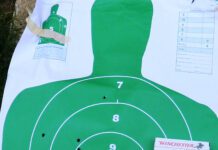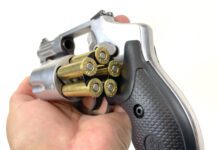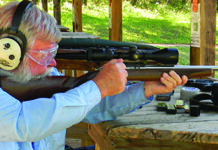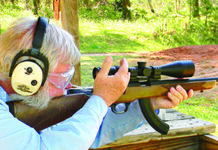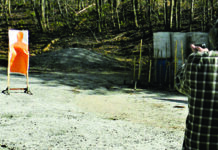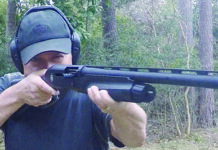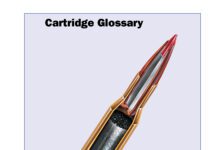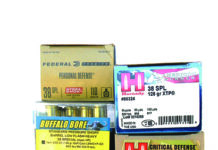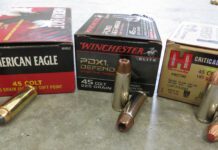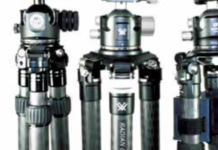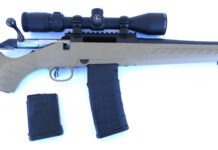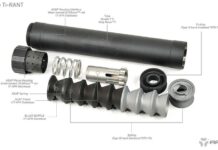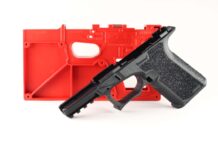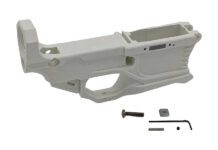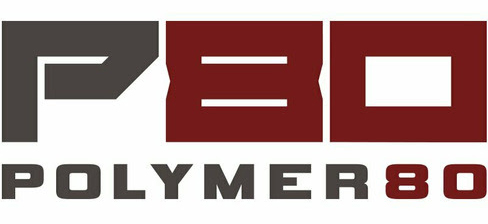A Better Price on SIG P226 CPO
Just got my December issue, and the first thing I noticed was the Guns of the Year choice of the SIG Sauer P226R as the "Best in Class Pistol." Had to snicker. I got mine at Bud's Gun Shop in Lexington, Kentucky. And it was as good as yours. When I first looked at it, I did the field strip, and it looked brand new. I am not an expert on SIGs, but I carried a 226 in 9mm for many years. I was just happy to hear the same story on the Certified Pre-Owned model. The bit of a snicker I had was because I only gave $636 for mine, whereas you paid $725. I also bought a 357 SIG barrel for it, and I am happy to say it handles the 357 SIG as well as the 40 S&W you tested. Thanks for the great article.
2016 Guns & Gear Top Picks
Toward the end of each year, I survey the work R.K. Campbell, Roger Eckstine, Austin Miller, Robert Sadowski, David Tannahill, Tracey Taylor, John Taylor, Rafael Urista, and Ralph Winingham have done in Gun Tests, with an eye toward selecting guns, accessories, and ammunition the magazine's testers have endorsed. From these evaluations I pick the best from a full year's worth of tests and distill recommendations for readers, who often use them as shopping guides. These choices are a mixture of our original tests and other information I've compiled during the year. After we roll high-rated test products into long-term testing, I keep tabs on how those guns do, and if the firearms and accessories continue performing well, then I have confidence including them in this wrap-up.
Ruger Introduces a Bevy of New Rifles and Pistols Mid-Year 2016
The American-made LCP II is built on a one-piece precision-machined anodized-aluminum chassis with integral frame rails and fire-control housing. Additional features include a through-hardened alloy steel slide; a black, one-piece glass-filled nylon grip frame; a textured grip frame to provide a secure and comfortable grip; a finger grip extension floorplate that can be added to the magazine for comfort and more secure grip, and a blued, alloy steel barrel. The LCP II ships with one 6-round magazine.
Compact 45 ACP Shoot-Out: Glock, S&W, and Springfield
The compact self-loading pistol is easily the most popular personal-defense handgun in America. Shooters realize that small-bore handguns may not have sufficient potential for personal defense. The 9mm Luger is the baseline for personal defense in most shooters' eyes. The 40 S&W isn't as popular due to the stout recoil it produces in compact handguns. After all, many 9mms and 40s are built on the same frame. The 45-caliber compact is slightly larger, and the lower-pressure 45 ACP gives a hard push in recoil rather than the sharp jolt experienced with the 40.
To see how our shooters rated a trio of smallish 45s, we acquired three handguns based on the service-size Glock 21, Springfield XD, and S&W M&P handguns.
l From Glock comes the single-stack polymer-frame G36, which is popular, reliable, and well suited to personal defense. The Glock G36 PI3650201FGR 45 6R FS, $561, isn't the most popular Glock by a long shot, but a number of Glock fans, as well as 45 ACP fans, like the Glock 36 handgun for its simplicity and ease of use.
l Another gun in the test was Springfield Armory's XD-S, a downsized XD with a slim single-stack grip. The Springfield Armory XD-S 3.3 XDS93345BE 45 ACP, $419, is even more compact than the Glock, with a short grip frame and a five-round magazine.
l The latest arrival in the polymer-frame 45 single-stack scene is the Smith & Wesson M&P45 Shield 180022, $399. The Shield series have been popular and well accepted by concealed carry handgunners, so making a 45-caliber version of it is a natural choice.
We test-fired the pistols with a total of five loads. The first was a handload with Magnus Cast bullets (#803 225-grain Flatpoint) and 4.8 grains of Titegroup powder. Our other test loads came from CheaperThanDirt.com. One was the HPR 230-grain JHP 45230JHP ($38/50 rounds), a Hornady 200-grain XTP ($15.28/20), a Hornady 230-grain XTP +P 9096 ($16.25/20), and a Fiocchi 230-grain Extrema JHP 45XTP25 ($17.24/25). We fired the handload during the combat firing test stage, shooting 50 cartridges in each pistol. We also fired a magazine of the Hornady 230-grain +P in these stages to evaluate recoil in each handgun. The HPR 230-grain load, the Hornady 200-grain load, and the Fiocchi 230-grain Extrema were used in accuracy testing. During the course of our testing, the three pistols never failed to feed, chamber, fire or eject, so reliability isn't an issue.
As may be expected, these compact 45s are popular with fans of each company's full-size 45s. But that isn't the whole story. As we discovered, fans of the full-size Glock may prefer the XD-S and our Springfield XD fan preferred the Glock 36 compact, and so it went. The primary difference was in handling, we found. Here are our findings.
Bersa Firestorm .380 ACP, $307
Back in April 2006 Gun Tests magazine tested three .380 ACP pistols, one of which was the Walther PPK, as made here in the U.S. under license by Smith & Wesson. They loved the well-built little PPK, even though it had to go back for rework before they gave it a clean bill of health. It had failed in DA shooting, but a stiffer spring gave it the equivalent of their Grade A appraisal. They recently found a gun that looked a lot like the PPK, the FireStorm by Bersa ($307 MSRP), from Argentina. Here's what they found.
Kimber Eclipse Target II 45 ACP, $1393
We compared two full-size 1911 handguns in the June 2013 issue to see which model offered the most bang for the buck. This Personal Defense test pitted two pistols of disparate price points to see if the less expensive model offered enough to consider it versus a fully equipped modern handgun. Tested were the Rock Island Armory Standard GI No. 51421 45 ACP, $410; and the Kimber Eclipse Target II 45 ACP, $1393. Here's an excerpt of that test.
1911 Magazines: Some Are Good, And Some Should Be Avoided
Magazines for the 1911 pistol have evolved more during the past two decades than during any other time since the pistol's introduction. The bane of the 1911 is cheaply made magazines, with poor ammunition close behind. For many years, the only choices were Colt factory magazines, which were usually high quality, then GI magazines, and poorly made gun-show magazines. Some were marked COLT 45 on the base in bold letters, and these usually meant the shooter was the real deal. At a time when new Colt magazines were around $15, aftermarket magazines sold for as little as $4, and most of them were not worth the aggravation. GI magazines were good quality, but shooters often found them bent and worn out, unless they were new in the wrapper. Quite a bit of barrel feed-ramp polish and tuning of extractors went on that probably was tied to ammunition and magazine problems. Some of the aftermarket magazines were not properly welded. In other cases, the follower was too tight in the magazine body; and in other instances, the magazine springs were weak. Others had poorly attached buttplates, that gave way when dropped on the ground during IPSC competition. Some survived, others did not.
The basic construction of the magazine itself has changed from sheet steel to aluminum and plastic followers versus metal followers. We have examined quite a few magazines that invited a situation called false slide lock. The follower appeared to catch the slide lock, but the slide lock was actually on the wrong shelf, which isn't good for any of the parts. A 1911 feeds by the loading block on the bottom of the slide stripping the cartridge forward as the slide moves forward. The cartridge case rim catches under the extractor and is pressed forward. Some feel that it is a good thing that the bullet nose snugs a little over the feed ramp and bumps the cartridge case head into the breech face as the cartridge enters the chamber. Some magazines, notably the Wilson Combat, allow the bullet nose to strike much higher on the ramp, which results in missing the feed ramp's edges more so than others.
…
5.56mm Pistols from Kel-Tec, Spikes Tactical, and CMMG
It could be argued that the AR pistol evolved out of a desire and need for shooters to own a legal short-barrel rifle-caliber weapon without having to jump through BATFE hoops or pay for a tax stamp to own an SBR (short-barreled rifle). The difference between an AR rifle and pistol comes down to the pistol not being compatible nor able to attach a stock. We wanted to take a look at these AR pistols for home defense and other uses where a compact firearm makes sense, because they offer a number of benefits over a conventional AR rifle, mainly, being more maneuverable while being chambered in a rifle caliber and being compatible with common AR-15 magazines. We acquired three examples, a Spike's Tactical The Jack custom build, a CMMG Mk4 K, and a Kel-Tec PLR-16. The Spike's and CMMG are true AR-15 mechanisms reconfigured to a pistol, while the Kel-Tec uses a different operating mechanism. All three are chambered in 5.56mm NATO/223 Rem. and all are compatible with AR-15 magazines.
We tested these pistols for accuracy, performance, reliability, compatibility with a range of AR-15 magazines, maintenance, ability to be customized, and cost. We found that the Kel-Tec was inexpensive compared to the CMMG and Spike's Tactical pistols. The Kel-Tec, however, needed to be operated differently. The CMMG and Spike's were an easy transition from AR rifle to AR pistol. An AR pistol, as we found out, is nearly as effective as a full-size AR at close to mid range. With the right ammunition, they could be tuned to be a very capable home-defense choice for anyone in the family competent to operate a firearm. Namely, using frangibles to limit overpenetration through walls and doors while still supplying lots of pop.
The AR pistol's edge is its size, but it is also a disadvantage, as an AR pistol is not as easy to shoot as a rifle or a traditional handgun. They are large and require two hands to effectively deliver accurate shots. You could get off a few shots holding an AR pistol with one hand, but the weight of the pistol causes muscle fatigue. A typical full-size handgun may weigh more than 2 pounds loaded, compared to these AR pistols, which weighed from 3.2 to 6 pounds unloaded. Add a pound or more for a 30-round magazine, and you've got a sidearm that would wear out nearly anyone who didn't transport them with a sling, just as you would with a rifle. We used one of the SIG SBX Pistol Stabilizing Braces ($149; SIGSauer.com) and found we liked to use the brace differently than intended, which we will get into shortly.
We also fired the pistols using a Blackhawk Storm Sling ($33.95; Blackhawk.com), a single-point sling with a built-in bungee cord, which many team members felt was an excellent way to carry and control the pistol. We tested with three different AR-15 magazines, including a Brownells USGI CS (Brownells.com; $14) constructed of aluminum, and two polymer magazines, the Magpul PMag Gen2 (Brownells.com; $12.30), and the FAB Defense Ultimag (TheMakoGroup.com; $25). For fast reloads, we also used a Kydex AR magazine carrier from IBX Tactical (IBXTactical.com; $35).
Building an AR pistol is not just a matter of installing a short barrel in a upper receiver and swapping out the receiver extension/buffer tube. Short barrels lose velocity and provide less dwell time for the projectile, so manufacturers need to tune and time the mechanism. A short barrel also needs to work on a range of loads from low- to high-quality ammunition. Reliability can be an issue.
Hands down, the CMMG and Spike's offered more customization than the Kel-Tec because they are compatible with a range of AR-15 aftermarket products — triggers, rails, pistol grips, BUIS, and more. The Kel-Tec is not as compatible. Also, for those testers already familiar with an AR-15, the CMMG and Spike's were much easier to maintain. But there's much more to consider, which we relate below:
Folks Liked the 380 ACP Review
While you didn't like the sights, short grip, or the long DAO trigger of the Kahr CW380, I loved all of them when comparing this gun to the others available at the time, especially the long smooooooth trigger. What a wonderful trigger the Kahr has! Once I bought it, I began adapting it to my own needs and use. First, I added two additional magazines and a pair of Pearce grip extenders, then added a Hogue rubber grip. The Pearce grip extenders allow me to get all three fingers on the grip, and the Hogue makes it extremely comfortable. Next I added a Crimson Trace laser for low-light situations. Now, I have what I consider to be a perfect pocket pistol. It is invisible in a pocket holster. Sorry to disagree, but IMHO, the LCP doesn't come close to my Kahr. I suggest everyone adapt whatever they buy/use to their hands, eyes, stance, needs, and abilities to maximize its utility. Then practice, practice, and practice.
Optics-Ready: M&P9 Ported, FNX-45 Tactical, G17 Gen4 MOS
If there is one new trend taking hold of pistol manufacturers, it is making optics-ready pistols. These handguns come out of the factory with the ability to mount a reflex-style red dot sight. The newest is the Glock G17 Gen4 MOS, which debuted in 2016. Kahr, SIG, and the Canik from Century Arms may also see optics-ready models in 2016. Custom gun makers have been crafting pistols with reflex sights for years, and back in 2012, both S&W and FN launched optics-ready pistols. Just like Picatinny rails have emerged as a widespread feature and laser pointers are being offered on many handgun variants, the optic mount is the next evolution of the handgun. We have seen this same scenario play out with AR rifles, where optics were once an anomaly and they are now the norm. Why? Ease of aiming and faster target acquisition. What, perhaps, has slowed the trend is cost. Reflex sights can add anywhere from $240 to $600 extra, depending on the sight. There may also be a need to purchase a new holster to accommodate the optic on the handgun and taller iron sights. This seems a little odd to us because many shooters might consider the cost to be excessive on a handgun, but we don't think twice about mounting a high-quality optic on a rifle. There is no doubt that in the same situations, red-dot reflex sights allow users to aim faster and easier compared to iron sights. Also, reflex sights allow users to aim with both eyes open, peering through a small glass lens that the sight uses to project a reticle onto it via a light-emitting diode. The sight provides an unlimited field of view since there is no magnification and no tube, so tunnel vision is less of an issue when aiming. Also, there is also no need to align three planes — target, front sight, and rear sight — as with iron sights. However, during testing, we found that taller iron sights that co-witnessed with the red dot were preferred because they can help find the dot. Also, BUIS are there in case the optic fails or the battery dies when we need it most. A proper maintenance schedule can alleviate this concern. To see how various red dots could be mounted and used on factory optics-ready pistols, we acquired a Glock G17 Gen4 MOS, an S&W M&P9 Performance Center Ported model, and an FN America FNX-45 Tactical FDE. The Glock and S&W were 9mm striker-fired pistols that are well known to us. We have reviewed numerous Glock G17 models over previous model generations, but this is first G17 Gen4 MOS that our testers have evaluated. The same is true with the S&W M&P9. We have tested other variants of the M&P9, but this is a first for the S&W M&P9 Performance Center Ported model. The 45-caliber FNX-45 Tactical is also new to our testers. What we were looking for with these optics-ready pistols was ease of installation, accuracy, ease of use, and durability.
Practical Target Guns: Kimber And Springfield Go Head to Head
In this installment, we pit two practical target guns against each other. By practical target guns we mean accurate and useful 1911 handguns suitable for personal defense, hunting, and some forms of competition. They are not so specialized that they are not holster guns or unreliable for general use. Some target guns simply are not as robust as these handguns.
Fragile sights that overhang the slide too far, as an example, are counterintuitive in an all-round packing gun. If an adjustable sight loses its zero in competition, you will lose the match. Losing zero in a personal-defense situation carries a stiffer penalty for failure. Getting down to the nitty-gritty, fiber-optic front sights are not always desirable in a hard-use handgun because they tend to be fragile, even if they deliver superior targeting performance.
On the other hand, a service pistol or a hunting pistol with adjustable sights is desirable given the wide range of bullet weights and velocity available with the 45 ACP cartridge.Gun Testsreaders already know that the 1911 Government Model platform is a versatile, go-anywhere do-anything handgun; but the question is, can target performance translate to defensive reliability and handling?
When the National Matches got into full force after World War One, improvements were undertaken on the 1911 handgun. Barrels were welded up and carefully fitted, and high-profile sights were fabricated. These improvements led to the Colt National Match pistol's introduction in 1933. The National Match featured a hand-honed action and two-way adjustable sights. Law officers and outdoorsmen also adopted this relatively expensive handgun. Changes and modification led to the Colt Gold Cup. The sights were fragile in many renditions — not the case in the newest models — so the shooter wishing to own a service-grade handgun with target sights had to take the custom route. Expedients, such as fitting Smith & Wesson revolver sights to the 1911 slide, were not always successful, but the Bo-Mar sight was an excellent addition to any 1911.
High-visibility adjustable sights are a good thing to have, provided they are reliable in keeping zero, are not fragile, and aren't likely to be damaged. Today, we have the best adjustable-sight 1911 pistols yet from the factory, and our two tests guns put them to excellent use. Here's how they performed.
Full-Size 10mm Pistols from SIG, Glock, and Rock Island Arsenal
The 10mm Auto cartridge seems to be going through a renaissance. There is new ammunition being manufactured in velocities the 10mm was intended for, like in the newer SIG Elite Performance ammo, and firearms manufacturers such as Glock and SIG have offered new pistols chambered in the round, the G40 Gen4 MOS and P220-10, respectively. We wanted to take a look at the 10mm in a full-size pistol that we could easily open-carry on the back 40 or concealed under a jacket or coat for in town. Since there are numerous examples of 10mm pistols to test, we also wanted to see if a different platform favored the big-bore caliber.
As we tested, we gained renewed respect for the 10mm round. Some testers even thought the round may be a liability in a self-defense situation due overpenetration. If we were in a crowded mall and were able to get solid center-of-mass hits on an attacker, we wondered whether certain loads would overpenetrate and hit a bystander. We do think it is a good round to punch through vehicles with and to stop big bears, and we also feel it is an excellent hunting cartridge if kept to bow-hunting distances on feral swine, whitetails, and small black bears. Around bystanders, we would most likely stick with the 10mm Lite or 10mm FBI loads if we carried the 10mm concealed.
The 10mm Auto creates a maximum pressure in the range of 37,500 psi. Compare that to the 45 ACP, which has about 21,000 psi with 230-grain ball ammo. The round was the brainchild of Jeff Cooper and a few like-minded individuals who wanted better terminal ballistics than the venerable 45 ACP could produce. The 10mm Auto exceeds 357 Magnum power and is very close to that of the 41 Magnum. The 10mm Auto is a brute of a round with the type of recoil you would expect from a magnum revolver. The mythical Bren Ten was one of the first semi-automatic pistols chambered in the round. The pistol never really lived up to its expectations due to magazine difficulties and the 10mm Auto thoroughly trouncing the Bren Ten's mechanism. The 10mm Auto has such a fast-moving bullet that it tends wreak havoc with the pistol's recoil mechanism. Colt first chambered its 1911 Series 80 in the cartridge in 1987, and it caused receivers to crack where the slide stop fits into the receiver. A relief cut was made by Colt to fix the situation, and the company's pistols in 10mm ran fine thereafter. When the FBI adopted the round after the Miami-Dade shoot out in 1986 due to agents' underperforming handgun cartridges, the Bureau soon realized agents could not or had a hard time handling the recoil of the 10mm Auto. The Bureau had adopted the cartridge first, then adopted the S&W Model 1076, which was purpose-built for the round. The FBI's solution was to load the 10mm light, which made it more tolerable to agents. The 10mm loads became known as 10mm Lite or 10mm FBI. We all know the light 10mm load is nothing but a 40 S&W in a longer case. The 10mm Auto produces about 300 foot-pounds more energy than the 40 S&W when the 10mm Auto is loaded to its standard velocity, and it's even hotter with niche ammo like that from Buffalo Bore. The 40 S&W changed the way law enforcement looked at cartridges, and the 10mm Auto might have been forgotten if it were not for some diehard fans — one of whom is on theGun Testsstaff.
Our shooters chose three very popular platforms to test the 10mm Auto: a 1911 design from Rock Island Arsenal (RIA), the SIG P220 model, which custom gunsmiths have been converting to 10mm for years, and the large Glock frame, which has been chambered in 10mm since 1991. All of these pistols in other calibers, namely 45 ACP, have received high grades in the past from us, so our expectation was these pistols would perform, and they did. All the pistols ran exceptionally well, with no malfunctions or jams. That says a lot because some 10mm Auto pistols are finicky because factory ammo is loaded light, standard, and heavy. We used an assortment of ammo; two light loads from Federal and two standard 10mm Auto loads from SIG in the Elite Performance Ammunition line, that are much faster than the Federal's load. The Federal loads consisted of American Eagle 180-grain FMJs which clocked slightly over 1000 fps, and Personal Protection 180-grain Hydra-Shok JHPs, which had an average muzzle velocity of slightly under 1000 fps. The SIG ammo averaged well over 1200 fps, except for the V-Crown 180-grain JHP in the Glock. The Glock showed lower velocity across the board with all the ammos compared to the SIG and RIA. Note the Glock barrel is also half an inch shorter than the RIA and SIG barrels.


